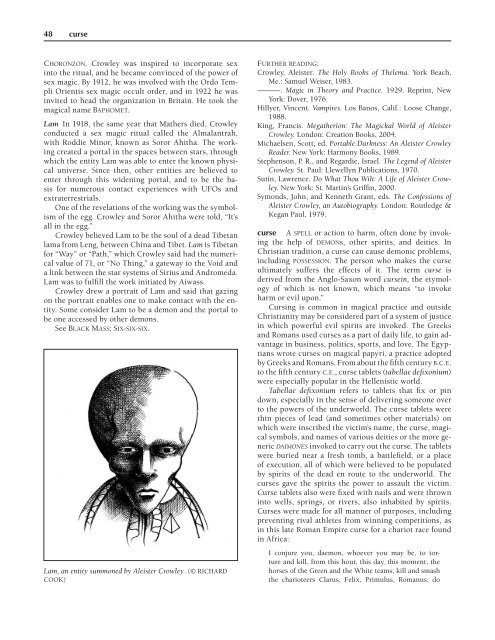The Encyclopedia Of Demons And Demonology
The Encyclopedia Of Demons And Demonology
The Encyclopedia Of Demons And Demonology
You also want an ePaper? Increase the reach of your titles
YUMPU automatically turns print PDFs into web optimized ePapers that Google loves.
48 curse<br />
CHORONZON. Crowley was inspired to incorporate sex<br />
into the ritual, and he became convinced of the power of<br />
sex magic. By 1912, he was involved with the Ordo Templi<br />
Orientis sex magic occult order, and in 1922 he was<br />
invited to head the organization in Britain. He took the<br />
magical name BAPHOMET.<br />
Lam In 1918, the same year that Mathers died, Crowley<br />
conducted a sex magic ritual called the Almalantrah,<br />
with Roddie Minor, known as Soror Ahitha. <strong>The</strong> working<br />
created a portal in the spaces between stars, through<br />
which the entity Lam was able to enter the known physical<br />
universe. Since then, other entities are believed to<br />
enter through this widening portal, and to be the basis<br />
for numerous contact experiences with UFOs and<br />
extraterrestrials.<br />
One of the revelations of the working was the symbolism<br />
of the egg. Crowley and Soror Ahitha were told, “It’s<br />
all in the egg.”<br />
Crowley believed Lam to be the soul of a dead Tibetan<br />
lama from Leng, between China and Tibet. Lam is Tibetan<br />
for “Way” or “Path,” which Crowley said had the numerical<br />
value of 71, or “No Thing,” a gateway to the Void and<br />
a link between the star systems of Sirius and <strong>And</strong>romeda.<br />
Lam was to fulfill the work initiated by Aiwass.<br />
Crowley drew a portrait of Lam and said that gazing<br />
on the portrait enables one to make contact with the entity.<br />
Some consider Lam to be a demon and the portal to<br />
be one accessed by other demons.<br />
See BLACK MASS; SIX-SIX-SIX.<br />
Lam, an entity summoned by Aleister Crowley (© RICHARD<br />
COOK)<br />
FURTHER READING:<br />
Crowley, Aleister. <strong>The</strong> Holy Books of <strong>The</strong>lema. York Beach,<br />
Me.: Samuel Weiser, 1983.<br />
———. Magic in <strong>The</strong>ory and Practice. 1929. Reprint, New<br />
York: Dover, 1976.<br />
Hillyer, Vincent. Vampires. Los Banos, Calif.: Loose Change,<br />
1988.<br />
King, Francis. Megatherion: <strong>The</strong> Magickal World of Aleister<br />
Crowley. London: Creation Books, 2004.<br />
Michaelsen, Scott, ed. Portable Darkness: An Aleister Crowley<br />
Reader. New York: Harmony Books, 1989.<br />
Stephenson, P. R., and Regardie, Israel. <strong>The</strong> Legend of Aleister<br />
Crowley. St. Paul: Llewellyn Publications, 1970.<br />
Sutin, Lawrence. Do What Thou Wilt: A Life of Aleister Crowley.<br />
New York: St. Martin’s Griffin, 2000.<br />
Symonds, John, and Kenneth Grant, eds. <strong>The</strong> Confessions of<br />
Aleister Crowley, an Autobiography. London: Routledge &<br />
Kegan Paul, 1979.<br />
curse A SPELL or action to harm, often done by invoking<br />
the help of DEMONs, other spirits, and deities. In<br />
Christian tradition, a curse can cause demonic problems,<br />
including POSSESSION. <strong>The</strong> person who makes the curse<br />
ultimately suffers the effects of it. <strong>The</strong> term curse is<br />
derived from the Anglo-Saxon word cursein, the etymology<br />
of which is not known, which means “to invoke<br />
harm or evil upon.”<br />
Cursing is common in magical practice and outside<br />
Christianity may be considered part of a system of justice<br />
in which powerful evil spirits are invoked. <strong>The</strong> Greeks<br />
and Romans used curses as a part of daily life, to gain advantage<br />
in business, politics, sports, and love. <strong>The</strong> Egyptians<br />
wrote curses on magical papyri, a practice adopted<br />
by Greeks and Romans. From about the fifth century B.C.E.<br />
to the fifth century C.E., curse tablets (tabellae defi xonium)<br />
were especially popular in the Hellenistic world.<br />
Tabellae defi xonium refers to tablets that fix or pin<br />
down, especially in the sense of delivering someone over<br />
to the powers of the underworld. <strong>The</strong> curse tablets were<br />
thin pieces of lead (and sometimes other materials) on<br />
which were inscribed the victim’s name, the curse, magical<br />
symbols, and names of various deities or the more generic<br />
DAIMONES invoked to carry out the curse. <strong>The</strong> tablets<br />
were buried near a fresh tomb, a battlefield, or a place<br />
of execution, all of which were believed to be populated<br />
by spirits of the dead en route to the underworld. <strong>The</strong><br />
curses gave the spirits the power to assault the victim.<br />
Curse tablets also were fixed with nails and were thrown<br />
into wells, springs, or rivers, also inhabited by spirits.<br />
Curses were made for all manner of purposes, including<br />
preventing rival athletes from winning competitions, as<br />
in this late Roman Empire curse for a chariot race found<br />
in Africa:<br />
I conjure you, daemon, whoever you may be, to torture<br />
and kill, from this hour, this day, this moment, the<br />
horses of the Green and the White teams; kill and smash<br />
the charioteers Clarus, Felix, Primulus, Romanus; do












